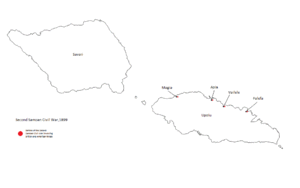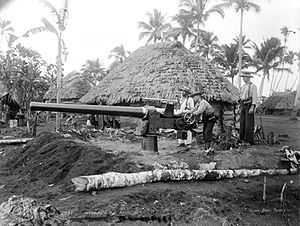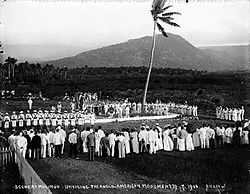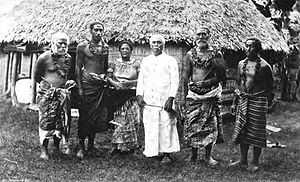Second Samoan Civil War
| Second Samoan Civil War | |||||||
|---|---|---|---|---|---|---|---|
 Map featuring the locations of battles in which British and American forces fought. | |||||||
| |||||||
| Belligerents | |||||||
|
Supported by: |
Supported by: | ||||||
| Commanders and leaders | |||||||
|
|
| ||||||
The Second Samoan Civil War was a conflict that reached a head in 1898 when Germany, the United Kingdom, and the United States were locked in dispute over who should have control over the Samoan island chain, located in the South Pacific Ocean. At the war's conclusion in 1899, the United States was granted the eastern section of the islands, the Germans were granted the western section of the islands, and the British were given other Pacific island chains formerly belonging to Germany.[1] The German half is now an independent nation: The Independent State of Samoa. The American half has voluntarily remained under the control of the American government as the territory of American Samoa.
Allies
The allies were the Samoan followers of Prince Tanu and supporting naval forces from the United States and the United Kingdom who fought against the rebels of Mata'afa Iosefo.[2]
History
As result of Malietoa Laupepa's death, Mata'afa Iosefo returned from exile and was elected to power by a council of Samoan chiefs. In response, the British Royal Navy and the U.S. Navy landed forces at Apia in support of Prince Tanu who was the legitimate heir to the Samoan throne which had already been taken over by the German-backed Mataafa.
The first battle of the conflict involving the British and Americans was fought at Apia, when the naval forces landed they occupied much of the city, Mataafan forces attacked, so British and American warships in Apia Harbor began bombarding enemy positions around the city. After the conflict, Mataafaite forces, as they were sometimes called, retreated to the stronghold of Vailele and thus began several American and British expeditions into the dense jungle to find the chief's men.[3]
Three American warships, USS Vandalia, USS Trenton and USS Nipsic and three German warships, SMS Adler, SMS Olga, and SMS Eber were keeping each other at bay over several months in Apia harbour, which was monitored by the British warship HMS Calliope. This standoff ended on 15 and 16 March when a cyclone wrecked all six warships in the harbour. Calliope was able to escape the harbour and survived the storm. Robert Louis Stevenson witnessed the storm and its aftermath at Apia and later wrote about what he saw.[4]
At the end of March, a joint expedition of British, American and Samoan forces marched along the coast from Apia towards Vailele. Skirmishes were fought and two villages destroyed as the Samoan rebels retreated. On April 1, the expedition of 26 marines, 88 sailors and 136 Samoans left the coast for an attack on the landward side of Vailele, leaving the protection of naval gunfire support. The cruisers USS Philadelphia, HMS Tauranga, HMS Porpoise and the corvette HMS Royalist landed the sailors and marines, Royalist was sent ahead of the expedition to bombard the two forts guarding Vailele plantation.[5]
The Second Battle of Vailele on 1 April was a defeat for the expeditionary forces, they retreated back to Apia and reported their casualties to their commanders who decided to plan for future operations in the area. On April 13, the British frontline was extended just south of Vailele and that day the Matafaans attacked but were repulsed. Another expedition later fought again within Vailele, this time the rebels won again when they withstood a British led attack on the two forts. The engagements occurred near the battlefield where Samoan rebels defeated German troops in 1889 during the first civil war on the island. A statue of Ensign Monaghan was erected in Spokane, Washington to commemorate the young officer's bravery.[6]
The war eventually resulted, via the Tripartite Convention of 1899, in the partition of the Samoan Islands into American Samoa and German Samoa.[7]
See also
- First Samoan Civil War
- Samoan crisis
- Mata'afa Iosefo
- Prince Tanu
- German Samoa
- Siege of Apia
- Battle of Vailele
Gallery
-

Tivoli Hotel in 1896, used as the command post for American force during the battle at Apia.
-

United States Marines and a naval gun in Upolu, 1899.
-

Samoan warriors and American servicemen during the Siege of Apia in March 1899.
-

German flag raising ceremony commemorating the creation of German Samoa in 1900.
-

Samoans, Americans and Britons holding a ceremony while erecting a monument on Mulinuu Peninsula, 1902.
-

Mata'afa Iosefo and followers, 1902.
References
- ↑ Ryden, George Herbert. The Foreign Policy of the United States in Relation to Samoa. New York: Octagon Books, 1975. (Reprint by special arrangement with Yale University Press. Originally published at New Haven: Yale University Press, 1928), p. 574; the Tripartite Convention (United States, Germany, Great Britain) was signed at Washington on 2 December 1899 with ratifications exchanged on 16 February 1900
- ↑ Mains, P. John; McCarty, Louis Philippe (1906). The Statistician and Economist: Volume 23. pg. 249
- ↑ Mains, pg. 24
- ↑ Stevenson, Robert Louis (1892). A Footnote to History: Eight Years of Trouble in Samoa. BiblioBazaar. ISBN 1-4264-0754-8.
- ↑ Mains, pg. 24
- ↑ Mains, pg. 24
- ↑ Ryden, George Herbert. The Foreign Policy of the United States in Relation to Samoa. New York: Octagon Books, 1975. (Reprint by special arrangement with Yale University Press. Originally published at New Haven: Yale University Press, 1928), p. 574; the Tripartite Convention (United States, Germany, Great Britain) was signed at Washington on 2 December 1899 with ratifications exchanged on 16 February 1900
| ||||||||||||||||||||||||||||||||||
